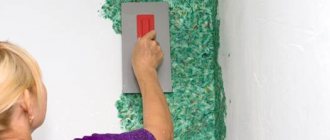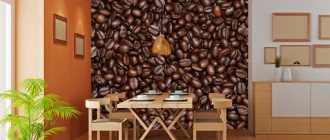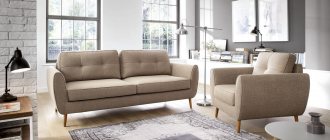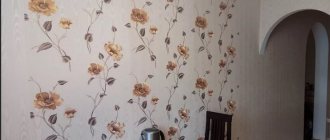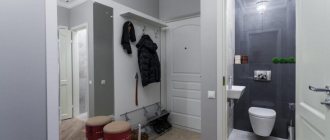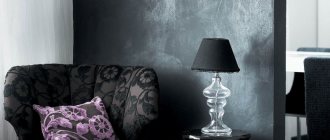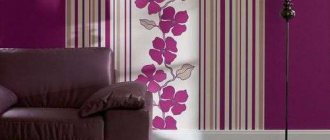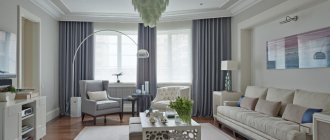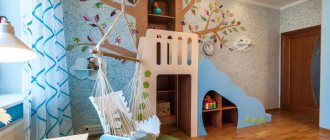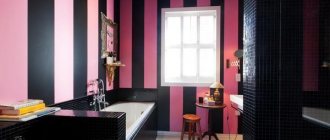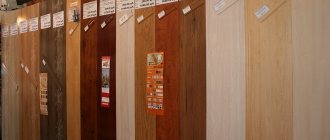Options and features of toilet wall decoration
There are many materials for finishing work. But are all of them suitable for hanging in the restroom? Which of them are more resistant to various factors influencing them.
- Vinyl;
- Paper;
- Non-woven;
- Liquid wallpaper;
- Washable;
- Glass wallpaper;
- Self-adhesive;
- Photo wallpaper;
- With a synthetic base.
It is not at all necessary to use plain and simple wallpaper in the bathroom
Choice of shades
Before deciding on the color scheme for the interior of this room, consider what effect different colors will have on the perception of the new design. For example, it is unacceptable to use dark wallpaper in a small toilet, as it will further reduce the space .
Considering that most toilets are limited in size, it is advisable to keep dark accents to a minimum.
A spacious toilet is usually combined with a bathroom. If your interior is large enough, you can choose wallpaper in brown, blue, black, purple and other dark shades. They can be plain or include bright and light patterns.
Light and warm shades are most . It is also possible to use a cold palette, but such a design will embody severity and will not always ensure the creation of a calm and relaxing atmosphere.
Gray, silver, snow-white and beige tones can be a good option for the design of toilet walls. They can be combined with brighter accents: yellow, light green, blue, lavender, pink.
Please note that toilets and bathrooms should maintain a balance between dark and light shades. If the walls of such a room are decorated in rich colors, use light furniture and accessories.
Consider the issue of lighting : if there are no windows in the room, ensure there are a sufficient number of lamps.
The dressing room will not be perceived as stylish and modern if you choose the wrong wallpaper pattern or pattern for the walls. But what’s even more difficult to guess is not the stylistic direction of the plot, but its impact on the size and appearance of the room.
Cramped rooms should not be decorated with wallpaper with a large print, even if you plan to decorate only one of the walls. Striped wallpaper will help visually expand the room.
Pastel-colored wallpaper with small, delicate patterns can also work, but high-frequency themes can create a feeling of discomfort. Therefore, think about how to balance this design: bright lamps, light furniture, and a large number of mirrors are suitable for this.
Color combination options
Absolutely all colors are suitable for the bathroom. It's up to personal discretion.
- White . Combines with absolutely all colors.
- Blue . Looks best with red, brown, blue, yellow, purple.
- Yellow . Suitable for green, brown, sand, red, blue.
- Green . Sand, cream, yellow, pink.
- Brown . Blue, yellow, green, black, red - all colors that will complement each other.
- Red . Yellow, orange, purple.
- Orange . Blue, green, purple, pink, brown.
- Pink . Brown, yellow, gray.
- Blue . Red, gray, yellow.
- Violet . All shades of yellow. Green and blue.
- Black . Suitable for almost all colors, in the right quantities.
In the bathroom you can combine tiles, mosaics, and wallpaper
Ways to combine materials in the toilet
Toilet design with wallpaper and tiles
tiles cover the walls most in contact with water; the upper part can be covered with wallpaper
This method is becoming one of the most justified for combined bathrooms. By tiling the area near the sink, you can easily protect the walls from water splashes and not worry about the finish deteriorating. The tile can cover only one area that is most in contact with water. It can also encircle the lower part of the walls. Everything else is covered with wallpaper. The colors of tiles and wallpaper should duplicate or complement each other.
Combination with a painted wall
combination of wallpaper with decorative stone in toilet design
If you don’t want to tile sections of the walls, you can simply paint them. A layer of paint will create a similar protective effect, thanks to which the wall will not be afraid of either water or mold. Dry areas not exposed to water can be decorated with wallpaper. If the lower half of the walls is painted and the upper half is pasted over, the tails of the wallpaper can be hidden behind the horizontal wall moldings.
Separation by color
dark-colored wallpaper is suitable for spacious bathrooms
This method is suitable for combining several types of wallpaper. With its help you can also visually transform the space of the room. For a small toilet, a mix of light-colored fabrics is preferable. Dark tones will be visually attractive, and this will make the wall appear smaller, so when using them, it is important not to overdo it. You can combine colored and plain wallpapers. Combinations of simple canvases with catchy patterns or a 3D effect look great.
Wallpaper for the toilet: advantages, disadvantages and design options
join the discussion
Share with your friends
The design features of the toilet largely depend on the decoration of the walls. In addition to the usual tiles, you can use wallpaper to decorate them. Given the variety of types of this finishing material, it is possible to achieve interesting design effects that will make this small room cozy and comfortable.
Wallpaper for the toilet
Beautiful wallpaper for the toilet is a practical finishing option, along with tiles or painting. This type of arrangement of a toilet room has a number of advantages.
Pros and cons of finishing
Wallpapering toilet walls has its advantages and disadvantages.
Among the advantages the following are noted.
- Wallpaper is easy to paste and remove from the walls. This allows you to quickly handle repairs on your own.
- Compared to other finishing materials, wallpaper is not very expensive. The services of a specialist for their stickers are also moderately expensive.
- A wide range of colors and textures. You can choose an option that will fit into any style. If you get tired of the drawing, the wall decoration can be easily updated.
- Such materials combine well with others, allowing you to get an original design solution.
- Thanks to wallpaper, you can create a calm, relaxing environment in the toilet room, necessary for anyone who comes here for needs.
If the wallpaper covering in any area comes off, tears, or scuffs or stains appear on it, it is easy to replace the affected part with the remnants of the material stored after the repair.
Among the disadvantages, the following nuances are highlighted.
- Since there is high humidity in the toilet, not all types of wallpaper can last long there. Some canvases quickly deteriorate in appearance or come off. Therefore, it is better to refuse some options, such as paper ones, in the toilet.
- Without being an expert in wallpapering surfaces, it is easy to make many mistakes. Moreover, it is very difficult to turn around in such an area, as well as to get to some places, for example, where pipes pass or behind the toilet. As a result, the appearance of the toilet will be unpresentable.
Source
Select a pattern
When renovating a small room, it is more important to choose light colors. Beige and silver are on trend. If we talk about drawings, the most popular now are stripes and canvases with abstraction.
To improve perception, designers are increasingly decorating one wall with material with a large pattern, and making the rest monochromatic in the appropriate color scheme.
The decorative material goes well with other types of finishing, especially with tiles, which are used to decorate the lower part of the walls to improve performance characteristics.
The space is visually enlarged when using light wallpaper with a barely noticeable floral pattern, as well as tiles in the same tone or a couple of shades darker for the floor and lower part of the walls.
Under tiles
Cloths that imitate tiles are more affordable than tiles and are easy to use. The design can resemble aged surfaces or be made into a beautiful stylized pattern. This option will speed up repairs or also quickly dismantle.
Under the brick
Imitation brick will allow you to effectively decorate walls, as well as save time and money compared to using natural brick. Such canvases look good in Provence and loft styles; the design is complemented by stylized plumbing items.
With flowers
Flowers will decorate any style, but can look different. For example, it is recommended to place photo wallpapers with large flowers on the far wall, and plain ones on the side surfaces. A small floral pattern can decorate the entire room.
Interesting floral design
Geometric designs
For small toilets it is allowed to use coverings with small geometric patterns. It will not look pretentious or reduce the space.
A technique that works well is using horizontal or vertical stripes, which will help visually improve the proportions of the room.
Wallpaper in the toilet: which one to choose and how to paste it
It just so happens that tiles are considered the most popular and practical material for finishing a toilet. But there are situations when, due to certain circumstances, its use is impossible. A very small area of the premises or limited financial capabilities force apartment owners to look for alternative renovation options. Previously, in such situations, the walls had to be painted or plastered, but recently it has become very fashionable to glue wallpaper in the toilet. Many are still skeptical about such ideas, but those who have already used this finishing option note that it is superior to ceramic coatings in many respects. So what are the advantages of wallpaper, what types of wallpaper are best to use to decorate a bathroom, and how to renovate this room yourself? We will consider these questions in this article.
Color solutions
For finishing a toilet, the most popular are light wallpapers - white, gray, light yellow, blue, beige and other light colors. There are also bright options, for example, in red, black or blue.
Two-color wallpapers with different prints are very popular.
Advantages of wallpaper over other materials
When planning to glue wallpaper in the toilet, first of all you need to focus on the quality of the products used. Here you should give preference to moisture-resistant options, since products based on paper and fabric will fail much faster.
• Finishing a bathroom with wallpaper will cost owners much less than laying tiles.
• A wide variety of colors, textures and images allows you to bring the most daring and unusual design solutions into reality.
• The use of rolled sheets greatly facilitates the renovation of the premises, so you can even do the work with your own hands.
• Decorating the toilet with wallpaper is ideal for those who like to change their decor frequently. If ceramic tiles are laid for many years, then roll materials can be changed almost every year.
As you can see, the use of such products is quite justified; all that remains is to decide on their type.
Combinations of wallpaper in the toilet in the interior photo
combining wallpaper and tiles in the toilet room
Different combinations of finishes will make the design of the toilet more interesting and memorable. The resulting setting should help create a comfortable atmosphere and be appropriate for the room.
black wallpaper contrasts with a white painted wall
Often, a combination of tiles and wallpaper is used in the design of a toilet, as in the photo below. So, by finishing the lower parts of the walls with tiles along the perimeter, you can make the cleaning process easier. Splashes of drops or dirt below will be easily wiped off the tile, and the wallpaper pasted above it will remain clean. As an alternative to tiles, other coatings are often used. Plastic or wooden panels will look unusual in this role.
black and white photo wallpaper in the interior
You can turn your bath or toilet into a green forest or seabed using photo wallpaper. They are usually preferred by people who want to add something innovative and original to their environment. With this coating you can not only place a beautiful picture on the wall, but also create an interesting visual effect. It will be possible to divide them between three walls. This move will look great in miniature rooms. But still, space matters here too: in a larger bathroom combined with a bathroom, you can show more imagination with the choice of design.
wallpaper in the toilet with floral patterns
Combination options
The assortment allows you to select the story you like from the many topics presented. Photo wallpaper with marine, natural or plant themes will look good in the design of the toilet. Instead of the usual one, you can choose a space or city landscape. It won’t be too difficult to assemble such a picture on the wall. An image with perspective will help to visually transform the space. The scale of the drawing also matters. If there are informative signatures on it, then it is better if they are large enough and readable.
wallpaper imitating tiles
The main role in choosing rolls for the bathroom should be played by their material. Without a moisture-resistant coating, a beautiful picture can quickly deteriorate and lose its attractive appearance.
decorating the walls in the toilet with wallpaper and PVC panels
A mix of wallpapers of different textures or patterns also allows you to create interesting combinations. The horizontal division method is suitable for finishing a toilet or bathroom. The upper part is covered with wallpaper with ornaments, the lower part is covered with plain wallpaper. Often, for the latter, a darker or richer tone is selected. In a duet with a patterned fabric it will look smart and harmonious. The strip at the junction in the center is sealed using moldings. Here you can also use the method of creating an accent wall. This area is covered with colored wallpaper, and the rest of the walls are covered with plain wallpaper. Most often, the area behind the tank is taken as the basis for finishing, if it is best visible from the entrance to the room.
combination of olive wallpaper with beige tiles
Vinyl based products
Vinyl wallpapers are made on a paper basis, but, unlike the cheapest analogues, they have a moisture-resistant polymer coating. Impregnation with special solutions makes this type not susceptible to mold growth, which allows them to be used even in the bathroom.
Such canvases are not the easiest to work with. Their heavy weight forces the use of extremely strong and moisture-resistant glue. After drying, the strips may shrink, forming gaps at the joints.
When choosing such material, you need to pay attention to the markings, which indicate whether it can be washed. Products depicting one wave can be wiped with a damp sponge. Two waves indicate that the product can be carefully cleaned using detergents. A drawn brush or three waves indicate a heavy-duty roll coating.
Kinds
When decorating a toilet, it is preferable to use the following wallpaper:
- Liquid. Such wallpapers are very similar to plaster, as they are sold in powder form. Before covering the walls with this wallpaper, they should be well leveled and treated with a primer with water-repellent properties. By mixing wallpaper granules with water, you get the consistency of a regular finishing mixture, which is applied to the prepared surface.
- Washable (non-woven). The main advantage of this type of wallpaper is the presence of an outer layer that can resist moisture. Pasting such wallpaper is quite simple if you pay attention to the joints and carefully smooth the canvas.
- Vinyl. They are often chosen for finishing a toilet, since such wallpapers are highly resistant to moisture. To glue such material, you should use a special glue that can hold a heavy canvas. In addition, due to the significant thickness of the sheets, such wallpaper can only be glued end-to-end.
- Glass wallpaper. This type of coating does not absorb liquids and odors, and is also not afraid of detergents. These wallpapers include fiberglass, have an interesting texture and can be painted.
- Ceramic. Such wallpapers are durable and highly resistant to moisture. They are made of thin porcelain stoneware and mounted using special adhesive mixtures.
Related article: Sakura on the wall - do-it-yourself drawing
Liquid wallpaper
In its original form, liquid wallpaper has nothing in common with roll materials. Many even consider them a type of decorative plaster. They are sold in the form of colored compositions made from small cellulose fibers. Decorating toilet walls with wallpaper (of this type) begins with mixing the working composition, which is applied to the walls in the same way as plaster.
The positive features of this material include the ability to hide minor irregularities and defects in the base, as well as high noise-absorbing qualities. To make the finished coating moisture resistant, it is coated with a layer of colorless varnish.
Selection of wallpaper for the toilet
First of all, let's determine the requirements for wallpaper for bathroom decoration.
Strength characteristics determine the durability of wall clothing. As a rule, the denser the wallpaper, the more resistant to abrasion it is, and since the toilet is limited to small geometric dimensions, this is relevant here.
An important aspect is that the denser the structure, the less porous the wallpaper, which means less stains and dirt will accumulate on the walls. This is important for the toilet, since cleaning will have to be done frequently using special care products.
Washable products
This option is the same vinyl wallpaper, only non-woven material serves as the base. They perfectly hide all irregularities, do not shrink after the glue dries, and, importantly, are very resistant to moisture. Wallpaper (washable) for the toilet can have different designs, but the most popular is the image of ceramic tiles. This option is optimal for lovers of classic bathroom design who, for some reason, cannot use tiles.
Non-woven wallpaper comes in two types: adhesive-based and paintable. The first type is distinguished by the presence of an adhesive base, and the second can be coated with coloring compounds up to 10 times. When choosing self-adhesive wallpaper for the toilet, you should pay attention to its water-repellent properties, since some options do not have such qualities.
Which wallpaper is best?
There are many types of wallpaper that are suitable for the toilet room. It is worth starting from individual preferences and characteristics of the bathroom.
Washable
Many people choose washable wallpaper, in other words, sheets of paper on which one or another design is applied. The surfaces of the material are protected with a waterproof film, thanks to which moisture will not cause them to peel off from the walls. This model has a low cost, and sticking it on the walls will not be difficult, which is a significant advantage. With a protective film, the wallpaper will not be afraid of dust, dirt, mold and mildew. This model has advantages over the usual paper one; it will last much longer.
With synthetic base
You can hang wallpaper that has a synthetic base. That is, they consist of textile fabrics glued to thin foam rubber. This finishing material has undoubted advantages: it is environmentally friendly and has good sound and heat insulation. Instead of wet cleaning, you need to clean this wallpaper with a vacuum cleaner.
Vinyl
Some people prefer vinyl wallpaper. They will not be cheap to repair, but this material is moisture resistant, so it will not be afraid of deformation from dampness and temperature changes. Gluing them is not difficult, you just need to take into account the special choice of glue that is suitable for heavy material. Vinyl wallpaper will not bubble or peel off the wall, its appearance will not change for a long time, it will serve for ten years or even longer.
Glass wallpaper
Another interesting option is glass wallpaper, which is made from fiberglass (paper and thin glass threads). The canvas itself is light gray, but then it is painted over with paint in different shades. These wallpapers are quite expensive, but they are worth it considering their characteristics. They are durable, so they will not wear off due to any damage for a long time (for this reason, they are used not only for bathrooms in apartments, but also for public toilets).
The fiberglass canvas will almost not absorb wet fumes, they are not afraid of chemicals and even aggressive substances (powders, solvents, etc.), so you can safely use a variety of detergents to clean them.
Fiberglass models have environmental and fire protection properties. Neither water nor fire will harm them. Another advantage is that this material can be painted in any color, which will allow you to turn interesting interior ideas into reality.
Source
Glass wallpaper
Fiberglass products are made by weaving thin strands of glass and paper. Initially, the canvases have a light gray color, which is subsequently painted over with water-based paint of any shade. Excellent performance characteristics, environmental friendliness, the possibility of repeated repainting, moisture resistance, fire safety - these are not all the positive qualities that such wallpapers have. This is an ideal option for a toilet in an apartment. True, if we talk about the financial component of the issue, then it should be noted that fiberglass products are much more expensive than previous analogues. But if you take into account the long service life of such a coating, then the costs are completely justified.
Toilet renovation where to start: design, cost, important points
Repairing a toilet in an apartment is not the easiest task, despite the seemingly small amount of work. The lion's share of difficulties is associated precisely with the size of the room and with the installation of plumbing and pipes in the toilet: risers, wiring, sewerage. Of course, it is better to entrust specific work to professionals, but cosmetic repairs can be easily handled without outside help. Let's find out how to do a toilet renovation yourself, saving time, nerves and money, and find out where it should start.
Photo wallpaper
Those who want to turn their bathroom into a real piece of art should take a closer look at photo wallpaper. The ability to choose an image to suit any interior style and taste of the owner makes these products very popular. Correctly selected drawings can visually expand a small space and add sophistication to it. Repairing a toilet with wallpaper (of this type) is difficult to do with your own hands.
Toilet design
Quite often, the toilet is a tiny room in which, as they say, it’s impossible to turn around. In houses of the 137 series, the toilet, which in addition to the riser and pipes also houses a ventilation shaft, is so small that there is practically no free space between the toilet and the door. In such a small space, design development before starting renovation requires a special approach. When thinking through the interior of a toilet, it is necessary to take into account some important nuances.
- The central object of the toilet is the toilet. First of all, it should be comfortable. Snow-white sanitaryware looks best, although other colors can be chosen. The main thing is that it fits the overall interior.
Preparing the base for wallpapering
First, let's figure out how to prepare the surface for liquid wallpaper, since this option for wall decoration requires special preparation.
1. First of all, it is necessary to clean the wall of old materials (putty, wallpaper, paint, etc.) and any contaminants that will certainly appear as a result of contact with water.
2. If there are large cracks, holes, holes and any other irregularities in the walls, they are sealed with a spatula and putty. This is necessary in order to reduce the wasteful consumption of wallpaper mixture. If deep recesses are not eliminated first, sudden changes in the thickness of the decorative layer will be very noticeable on the dried wall.
Wallpaper on a synthetic basis: properties and capabilities
The material includes a duo of textile fabric and foam backing. The finish has a pronounced sound and heat insulation effect and is easy to clean with a vacuum cleaner. The surface is not exposed to sunlight. To eliminate the risk of harmful microorganisms arising inside the coating in high humidity environments, it is worthwhile to provide a high-quality ventilation system in the hygiene room.
Application of liquid wallpaper
In order to glue liquid wallpaper in the toilet, you first need to prepare a working mixture. This process can be started at the stage of priming the surface, since according to the instructions, the solution for liquid wallpaper should be prepared for at least 6 hours.
The substance contains three main components:
In most cases, they are packaged in different bags, so you will need a large container to mix all the ingredients. The resulting mixture should not contain lumps. Dry fibers are gradually poured into the prepared water (in strict accordance with the instructions), kneaded and left for the time specified by the manufacturer.
The finished solution is scooped up with a small spatula and rubbed over the wall in an even layer using a special grater. The layer thickness is usually 3-4 mm. This way the entire wall is covered.
What is the order of work in the toilet?
Even a small repair of a toilet in a panel house will require a large number of different tasks. This small room contains many different communications: pipelines, sewerage, heating, lighting. Often the toilet itself needs to be replaced. In some cases, a defect report may be required for major repairs.
First you need to decide on the sequence of repairs in the toilet. Renovation in an old house or in a new building begins with the development of design and calculation of the necessary materials. It is advisable to perform further stages of repair in the following order:
- removing old coatings from ceilings and walls;
- replacement of heating risers and sewer pipes, installation of a toilet installation;
- replacement of wiring (if necessary);
- cleaning the premises;
- preparing the floor, pouring the screed, laying the floor covering;
- installation of wall coverings (wallpaper, tiles, panels);
- if necessary, assembly of a plumbing cabinet;
- toilet installation;
- installation of a new door.
Even the most modest toilet renovation takes a long time and requires a significant investment, since plumbing is expensive. The most inexpensive option for repairing a toilet is a simple cosmetic one, when you do not change the drain or wiring, but only refresh the ceiling and walls.
Working with rolled products
If all the preparatory work in the bathroom is completed, you can begin finishing the walls.
It is much more convenient to glue wallpaper when the pipes are hidden in plasterboard boxes and the plumbing has not yet been installed.
1. After making sure that the wall is sufficiently smooth and dry, we begin work.
2. Using a tape measure, measure the height of the wall from the ceiling to the floor. If the selected wallpaper does not require selection of a pattern, measure out several strips of the required length at once (taking into account a small margin at the edges). If the stripes are united by one pattern, first select the ornament on a clean and dry floor.
3. Depending on what material is used in this case, the glue can be applied in three ways: on the surface, only on the canvas, or on the wall and the roll at the same time. Taking into account the manufacturer's recommendations, we glue wallpaper in the toilet.
4. It is better to start pasting the wall from one of the corners. For the first stripe, you can make vertical markings. This way you will be sure that the wallpaper is placed on the wall without a slope. All subsequent canvases are glued end-to-end, carefully sealing the seams between the rows.
5. Using a special rubber roller, roll out the wallpaper, displacing any remaining air from underneath it. It is advisable that there are no drafts or sudden temperature changes in the room until the glue has completely dried.
Features of finishing the toilet room
To many, this idea may seem completely impractical, but this is only at first glance. Wallpapering the toilet room is a good option for many reasons, which can become not just a worthy alternative to tiles, but also an interesting and original design solution in the apartment.
But you should understand that in the bathroom there is high humidity and frequent temperature changes, so not all wallpapers will fit in this room, but only those that have a certain set of characteristics:
- It is not recommended to decorate the toilet room with simple single-layer paper, because it will soon get wet.
In addition, due to the small size of this room, frequent scratches are inevitable, as a result, even attractive wallpaper that is not adapted to the given conditions will soon have to look for a replacement.
- The toilet must be decorated with wallpaper that is moisture resistant, otherwise due to dampness it will simply begin to peel off from the walls. And the material, which is not afraid of moisture, will serve for a long time. At the same time, you won’t have to avoid wet cleaning in the toilet, which is necessary to prevent fungus and mold from appearing on the wallpaper.
- Wallpaper should not be too thin, as it will quickly wear off due to frequent mechanical damage, but it should not be too dense either. A material that is too heavy due to humidity will begin to move away from the walls under the pressure of its own weight, so it is better to give preference to lighter, but no less durable models.
- It is important to choose the right texture and shade of wallpaper so that it looks harmonious in the toilet room. Now stores offer a huge number of colors that will allow you to create an interesting and original design in your bathroom.
- Before you start gluing wallpaper during renovation, you need to prepare the toilet room: hide all the pipes, carry out communication before this. But the plumbing must be installed after the wallpaper has been hung, otherwise it will significantly interfere with the process.
Washable wallpaper
Washable wallpaper was specially created for use in various rooms with high humidity. Therefore, they are a suitable solution for kitchens, bathrooms, and toilets, where the problem of high humidity is especially acute. Such canvases can be combined with plaster finishing and tiled materials.
In black and white
When combining, the main thing is to correctly combine the shades and textures of various finishing materials. For example, if you choose embossed voluminous washable wallpaper, then the tiles should match. Color combinations are just as important, no matter what types of finishes are combined.
In the case of using washable wallpaper in bathrooms, experts give the following recommendations:
- The canvases must be combined with the overall style. A good example option is a combination of blue and green shades, which in the bathroom can create the effect of purity and harmony.
- If the room is small in size, then it is recommended to avoid using canvases in blue, red, and black shades.
- Bed and flesh tones will be a good solution when implementing a classic style in the interior of a bathroom. When choosing a Provence style, you can use washable wallpaper with a miniature floral print or vertical stripes.
- If the bathroom is medium to large in size, then the appropriate type of finishing would be canvases in orange and yellow shades. They will be able to bring more light and energy into the room.
Washable, suitable solution for kitchens, bathrooms, washrooms
When choosing washable 3D wallpaper, it is recommended to ensure that the canvas covers the entire wall. The image should not be interfered with by pipes, shelves and other plumbing and decorative elements. If the bathroom is small, then the image can be represented by a small bright picture.
Wallpaper and tiles
Decorating a bathroom with wallpaper and tiles is a smart solution that allows you to create an interesting, original interior. The solution is especially relevant if the room is not small (in small apartments, a variety of finishes will look ugly and colorful).
The following types of wallpaper are optimal for use in rooms with high humidity:
- vinyl;
- liquid;
- glass wallpaper;
- all types washable (eg metal coated, acrylic).
Product print with birds
Tiles and wallpaper - optimally dividing the bathroom into separate zones. For example, you can tile those areas that will get wet the most (floor, walls near the shower, bathtub, sink). It is recommended to paste wallpaper where the towel dryer, entrance to the room, toilet cabinets, towel rack, and washing machine are located.
Tip Don't forget about the color combination.
For example, beige tiles will look good only with black or white wallpaper or patterned canvases. It is necessary to pay attention to the junction of the two materials, because in the case of unevenness or curvature, it will be this that will catch the eye, and not the beauty of the design.
In green
Tile laying options
You can lay tiles using a variety of techniques - it all depends on your ideas, the intended design, and the size of the tile products. Popular installation options are:
- Traditional technique . Provides for laying tiles in even rows to form a single grid (regardless of the size of the products).
- With offset . Laying is done obliquely with a sideways shift with each subsequent product.
- Diagonally . In this case, installation is carried out from the corner of the wall or floor surface. A good solution to use is small square tiles.
Experts note that there are more than 40 different options for laying tiles. To create a unique, interesting design in your bathroom, it is recommended to explore different solutions. It is not recommended to combine tiles of different shades and sizes on your own (in this case, it is better to seek help from a designer).
Blue color of the product in combination with white
One solution for combining tile shades is to take black and white tiles (or products in other contrasting shades). In this case, it will be possible to easily choose wallpaper that matches the color (for example, beige canvases will be just perfect).
To create the decor of kitchens and bathrooms, traditional tiles, which are represented by small square products, are often used. Depending on the intended design and size of the room, the tiles can be small (no more than 10 cm) or larger.
Wall decoration
It is difficult to combine ceramic tiles and wallpaper in one room, as it may seem at first glance. If the bathroom is small, it is strongly not recommended to use bright finishes. If you want to do something catchy, you can paint one wall (for example, where the bathtub is) in a bright color.
A classic that never goes out of style
If one wall is bright and catchy, then the tiles and other canvases should be made in extremely calm, simple shades. This will make the room look harmonious and beautiful. For example, a bright blue or light blue finish on one wall will be perfectly combined with the bed tones of other finishing materials.
One of the most common techniques when using tiles and wallpaper in the same room is to create a vertical or horizontal line. It is formed using tiles of a different color (they should be small in size). Such a solution will allow you to decorate the interior (using a vertical line can clearly delimit the space into zones).
You can decorate and design your bathroom in an unusual way by alternating tiles in a checkerboard pattern. It is not necessary to choose black and white products - any type of tiles whose colors go well together will do. For example, these could be the following combinations: red-green, blue-orange, yellow-brown.
Combination of plain and printed wallpapers
Moisture-resistant wallpaper
Wallpaper with moisture-resistant properties is in demand and popular in the segment of finishing materials for kitchens and bathrooms. Such canvases are now available in various designs:
- Floral prints.
- Solid models.
- Striped.
- In a cage.
- With ethnic motives.
- With abstraction, with geometric shapes.
Wallpaper of this type is suitable for covering the entire room. But we recommend using combinations of different materials. This will allow you to create a high-quality room design, as well as extend the service life of the finish.
In light colors
It is recommended to combine two or more materials only if the area of the room is more than 5-6 square meters. For small bathrooms, you should choose simple design solutions without a combination of finishes and with a simple color scheme.
Where can I stick it?
When creating a bathroom design, it is necessary to take into account the practicality of using moisture-resistant fabrics. Several main areas can be distinguished:
- The first section is the wall surface above the bathtub, inside the shower stall, above the sink. These areas are most susceptible to direct exposure to water, so they try not to glue even moisture-resistant types of finishing materials to them.
- The second area is the surface 30-40 cm above the bathtub. It is considered suitable for the use of moisture-resistant canvases that have high strength and density.
- The third section is the area above 60-70 cm above the bathtub, sink, shower stall. These parts are considered relatively dry, so they are well suited for finishing with various types of wallpaper (but not ordinary paper).
- The fourth section is above 80 cm above the bathtub. A safe and suitable area for pasting, which can be used to combine different fabrics.
It is recommended to decorate areas in the room that are most susceptible to constant exposure to moisture with ceramic tiles and porcelain stoneware. Wallpaper should not be used in these areas.
Design ideas - combining materials
Moisture-resistant wallpaper is well suited for combination with other materials in the bathroom. With them, the combinations turn out to be harmonious, light, simple. This allows you to create an interesting and unique interior, even using inexpensive finishing materials.
A popular combination is the use of moisture-resistant wallpaper and tiles. Typically, ceramics are installed in areas that are exposed to direct water (the edge of the bathtub, near the sink, etc.). A good solution in this case is to glue the wallpaper above the tiles.
Combined with tiles
In the interior of bathrooms, tile materials are also often used to form mosaics on a separate surface or near plumbing fixtures. In this case, they try to choose wallpaper so that it matches the color and texture of the tile and does not stand out against its background.
If you want to create an environmentally friendly interior with an unusual design, then moisture-resistant wallpaper in the bathroom can be combined with stone or wood. Artificial or natural stone can be used in any texture and color scheme (it is easier to match the canvas to the stone than vice versa). If wood is used for the combination, it must be treated with moisture-proof compounds, otherwise it will quickly become unusable.
If you want to save a little on decorating your bathroom, you can use plastic panels. They also combine well with moisture-resistant wallpaper and are practical and easy to install. This is a good option for use together with photo wallpaper or single-color canvases.
Bohemian, classic style
Wallpaper with panels can be alternated or combined by zone. For example, the lower part of the room is decorated with panels, and the upper part with moisture-resistant fabrics. Plastic trim is almost always installed in areas exposed to water.
Vinyl wallpapers
Vinyl wallpaper is used in many countries around the world to decorate bathrooms and kitchens. They are presented in the form of two-layer canvases. The stores sell canvases with different patterns and color designs:
- Solid colors (red, white, gray, blue, yellow, etc.).
- Striped.
- Multi-ton.
- With an image.
- Embossed with a pattern.
Vinyl products are used in many countries around the world
For rooms with high humidity, you should choose vinyl wallpaper labeled “kitchen vinyl” . These are special washable sheets that were created for use in kitchens and bathrooms. The models are created on the basis of rubberized vinyl, which is resistant to moisture and dirt.
Often "kitchen vinyl" is used in bathrooms instead of or in combination with ceramic tiles. The material is relatively thick (compared to other types of canvas), so it will look rough in the room. Therefore, it is recommended to diversify it with suitable decoration solutions.
Suitable for areas with high humidity
What types of vinyl wallpaper are suitable for the bathroom?
The top layer in canvases of this type can be different. It determines the appearance of the coating, sound absorption, and thickness of the material. It is customary to distinguish several types:
- Smooth . Embossed, high-strength models, easy to clean. Decorated with brick, stone and other popular materials.
- Solid . Cloths with a dense structure that are resistant to various negative influences. They also imitate well-known finishing and building materials. You can choose an option to match your existing bathroom design.
- Silk . Canvases with a beautiful texture reminiscent of silk fabric. Such vinyl wallpapers are produced using silk-screen printing technology.
- Embossed foam vinyl . The presence of a foam layer allows the canvas to “breathe”. The models have a relief, clear pattern, so they are well suited for decorating bathrooms and kitchens (especially if there are slight unevenness on the walls).
Models are created on the basis of rubberized vinyl
The idea is that for rooms with high humidity, you can choose any type of vinyl wallpaper, based only on your preferences in appearance. Such canvases combine perfectly with ceramic tiles and other finishing materials.
Printing methods
When choosing canvases, it is recommended to pay attention to the technology that was used to print the design or pattern on the material. Manufacturers use different printing methods to apply images to vinyl. Popular ones are:
- Regular printing . It is used when a single color or simple patterns need to be applied to the canvas. Such models are monochromatic and can have traditional, simple images and designs, which are represented by patterns, figures, and ornaments.
- Photo printing . Canvases on which the image is applied using photo printing have a magnificent appearance. The applied drawing has good detail, high clarity, rich and bright shades. It was popular before, but now this solution is used relatively rarely in bathrooms and kitchens.
- UV printing. Vinyl is produced with bright, clear, slightly shiny images and patterns that have a three-dimensional effect. If bright light hits the surface, the canvas shimmers. An excellent option for bathrooms and bathrooms.
- Printing using stereoscopy technology . One of the most modern and interesting printing methods, the use of which allows you to obtain a 3D effect. The picture can be single, occupying the entire wall, or panoramic. Large enterprises can custom-make models that glow in the dark (due to built-in LEDs).
Creating accents
Vinyl wallpaper is great for highlighting the main area in the bathroom. To do this, it is recommended to use fabrics that have a contrasting shade. For example, if the floor and walls are (partially) tiled with white tiles, then one option is to create an accent with red vinyl wallpaper.
Bright room design option
You can cover two walls with eye-catching and bright wallpaper, continuing the composition to the ceiling. Upon entering the room, this composition will immediately catch your eye. It must be designed taking into account the existing interior style and the implemented color scheme.
A good solution for creating an accent is a combination of vinyl photo wallpaper with wallpaper of another type. It is recommended to glue photo wallpaper all over the wall. In this case, it is necessary to ensure that the color scheme of the overall composition matches the other finishing materials used.
